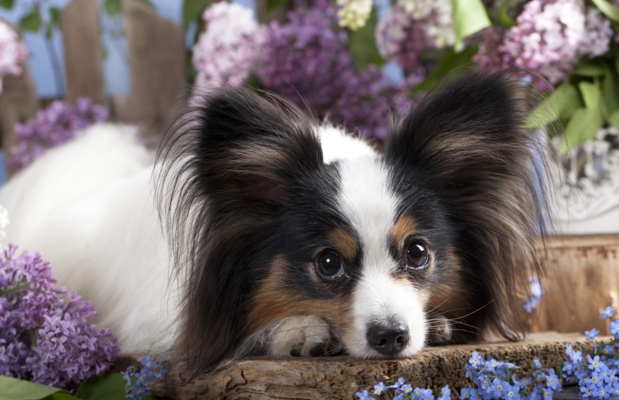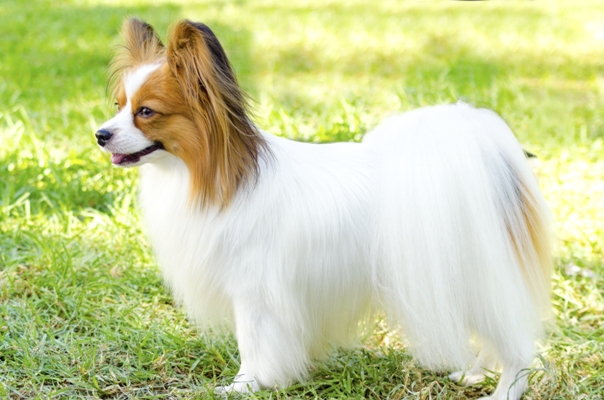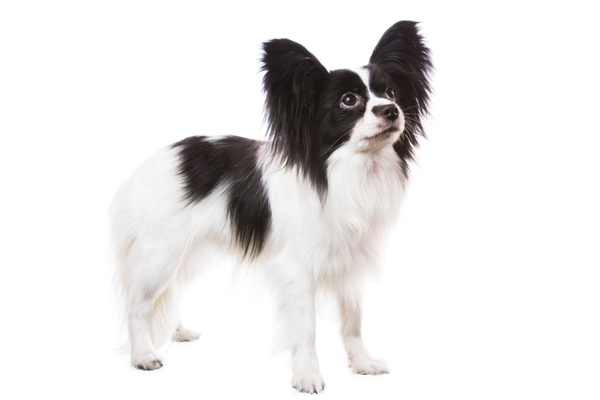Papillon
Active, intelligent
This breed has an around average probability of having health issues in its lifetime, hence it is one of the less expensive breeds to insure.

Is this breed right for you?
Try our breed selector quiz to find out your best matching breed!
Insuring a Papillon?
Get our award-winning Nose-to-Tail Cover with up to $30k annual benefit limit, up to 90% of eligible vet bills back, and no sub-limits.
Get a quick quoteBreed Overview
The Papillon is small, fine boned, energetic dog that is also known as the Continental toy Spaniel or Dwarf Spaniels. The Papillon has a long coat that is straight and fine and it does not have an undercoat. The most distinctive features of this small breed are its butterfly ears that are fringed with long hair. The hair on the Papillon’s body is medium in length and feathering also covers both the rear of the fore and hind legs. This dog has a distinctive proud tail that is also feathered with hair. This confident and cheeky little package makes the perfect lap dog.
The Papillon does shed a decent amount of hair so it needs regular grooming and a good brush each day will help with shedding. This dog comes in a variety of parti-colours that include white patches.

Personality and Temperament
Papillons are highly intelligent dogs who love to please their owners. They are easy to train and it is easily motivated to follow commands using food as a reward. This dog also has plenty of energy so it’s perfect for a family home. It is a great dog for first time dog owners and loves nothing more than to snuggle up on their owners lap for a quiet nap.
It’s a good idea to socialise the dog when it is a puppy to ensure that it’s comfortable and relaxed around other dogs and people.
They do have a tendency to bark.
Common Papillon Diseases & Conditions
Symptoms, diagnosis and treatment
- Brucellosis. This is a serious infection that can affect hunting dogs. It is passed on via feral pigs with clinical signs including fever, enlarged lymph nodes and enlarged testicles. This disease can also be passed from mothers to their pups meaning that the dogs don’t necessarily have to be in contact with a feral pig to present with the disease.
- Hypoglycaemia. Toy dogs are occasionally prone to low blood sugar (hypoglycaemia), a condition which can be treated easily but which can be fatal if left untreated. Hypoglycaemic puppies are often slow or listless and can be seen shivering or trembling. If these signs are present in the dog, put some honey under its tongue and take it to the vet immediately.
- Patellar luxation is a condition common among small breeds, and occurs when the thigh bone, knee cap and calf are not in correct alignment, leading to lameness or an irregular gait (often a skip or a hop) and development of arthritis later in the dog’s life. The condition is usually fixable with surgery, but dogs with less serious cases often do not require treatment and are able to lead normal lives.
- Open Fontanel. Like babies, Papillons are born with a soft spot at the top of their head. Even though the spot usually closes, it is important to treat the puppy with extreme care as an accidental hit to the head could be fatal.
- Collapsed Trachea. Rapid inhalation can cause the trachea to flatten, making it difficult to receive air into the lungs. Symptoms include dry, honking coughing, intolerance to exercise, difficulty breathing and gagging when eating or drinking. Any dog exhibiting these symptoms should see a vet as soon as possible.
- Progressive retinal atrophy refers to a family of eye conditions which cause the retina’s gradual deterioration. Night vision is lost in the early stages of the disease, and day vision is lost as the disease progresses. Many dogs adapt to the loss of vision well, as long as their environment stays the same.
Not all conditions are covered by Pet Insurance. For details of Bow Wow Meow Pet Insurance cover, refer to the Product Disclosure Statement.

History
The Papillon is thought to have descended from Asian toy breeds like the Japanese Chin and on the other hand they are also believed to have resulted in the miniaturisation of European spaniels by continually cross breeding smaller dogs. Regardless of their ancient origins tiny spaniels were established by the 1200s across Europe.
The Papillon has featured in artwork from many well-known artists including Goya, Rembrandt, Tolouse-Lautrec and Marie Antoinette was an owners of the breed. The Papillon has long been a favourite of high society and it is claimed that the country of Spain is largely responsible for its popularity.
The Dwarf Spaniel originally had long folded ears during the reign of Louis the Great but over time some of the dogs were born with large erect ears. Modern day Papillons are identical to the Draft Spaniels of old and their ears can either be erect or drooping. Both drooping eared and erect eared Papillons can come from the same litter even if their parents both have the same ear type.
The French elected to name the Papillon, which means butterfly, because of its erect fringed ears. Throughout Europe the drooping eared Papillon is call the Phalene, which means ‘moth’, and in North America the breed is called a Papillon whether it has dropping or erect ears.
The Kennel Club of England accepted the breed in 1923 and the American Kennel Club recognised the breed in 1915.

Papillon Facts!
- These dogs are considered one of the top five dogs in the obedience training ring.
- Papillons are excellent rat catchers.
- It is alleged that King Henry II spent upwards of 100,000 crowns on his papillons.
- Celebrity Papillon owners include Christina Aguilera who has two Papillons named Chewy and Stinky.
- It is said that Marie Antoinette took one of her Papillons to the guillotine when she was executed.
- The Papillon first appeared in Australia in 1949.
Free engraved pet ID tag on sign up3
Customer Satisfaction
21 day cooling off
Easy to use Pet Portal

GapOnly® in vet claims
MORE INFORMATION:
Papillon Kennel Club of NSW: http://www.papillondogclubofnsw.com/





